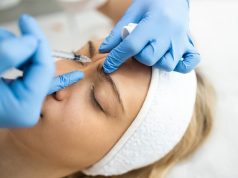The 74th Annual Meeting of the American Academy of Dermatology
The annual meeting of the American Academy of Dermatology was held from March 4 to 8 in Washington, D.C., and attracted more than 15,000 participants from around the world, including clinicians, academicians, allied health professionals, and others interested in dermatology. The conference highlighted recent advances in the diagnosis and management of dermatological conditions.
During one presentation, Tina Alster, M.D., of the Washington Institute of Dermatologic Laser Surgery and Georgetown University Hospital in Washington, D.C., discussed the use of lasers for multiple dermatologic conditions.
“Lasers have been used for decades to effectively treat a variety of dermatologic conditions, including birthmarks, scars, unwanted hair, tattoos, and aging skin. Laser systems have become so specialized that each device can be used for a particular condition, making the procedures highly effective,” Alster said. “With the introduction of additional technologies such as radiofrequency, microfocused ultrasound, and microneedling, patients have been able to pursue multi-combination treatments in order to achieve enhanced clinical effects without increased post-treatment side effects or complications.”
According to Alster, currently available treatments can be performed singly or in combination to achieve better cosmetic outcomes with a lower risk of complications and a shorter recovery time.
“It is important that physicians be experienced with multiple laser treatments and devices in order to enhance clinical outcomes,” Alster said. “Newer treatment technologies are always being developed. It is important to keep abreast of these technologies so that patient care is optimized. A deep understanding of treatments and a healthy respect for their potential side effects and complications are essential to drive further innovations in the field.”
During another presentation, Carrie Kovarik, M.D., of the University of Pennsylvania in Philadelphia, discussed how patients should be cautious when using teledermatology that includes the use of dermatology websites and phone applications.
“The use of teledermatology has increased as the technology has developed to accommodate it and the data have been developed to support it,” Kovarik said. “Teledermatology can increase access to care when done appropriately, but there are definitely pitfalls.”
According to Kovarik, there are several things patients can do to improve the outcome of a consult with a dermatologist via websites and/or applications, such as only sending consults to dermatologists who are board certified in the state in which the patient resides and only using sites where the patient is allowed to pick a provider.
“Patients should make sure they share the record of the encounter with their regular health care providers (primary care physicians, dermatologists, and any other relevant providers), and make sure the service has a back-up plan for an in-person visit if a teledermatology consultation cannot resolve the issue,” Kovarik said. “Patients should not solely rely on teledermatology, and if there is ever any doubt, they should see their providers in person.”
Lawrence F. Eichenfield, M.D., of University of California at San Diego, and colleagues presented evidence that a novel nitric-oxide releasing gel, SB204, is significantly superior to vehicle gel in treating moderate to severe acne over a 12-week period. The investigators evaluated 213 patients with moderate to severe acne treated with either 2 or 4 percent gel or the vehicle gel.
“There was significantly greater improvement in inflammatory lesions and non-inflammatory lesions, and statically superior percentage of patients who made the defined end point of clear and almost clear, and a 2 or greater decrease in the Investigator Global Assessment score (from severe to mild or better, from moderate to almost clear or clear),” Eichenfield said. “The 4 percent gel once a day reduced inflammatory and non-inflammatory lesions, with inflammatory lesions reduced by week four, with good cutaneous tolerability. The study shows tremendous promise for this approach to acne therapy and particularly for the 4 percent gel being studied in future phase 3 trials.”
Several authors disclosed financial ties to pharmaceutical companies, including Novan, the manufacturer of SB204.
Copyright © 2016 HealthDay. All rights reserved.







